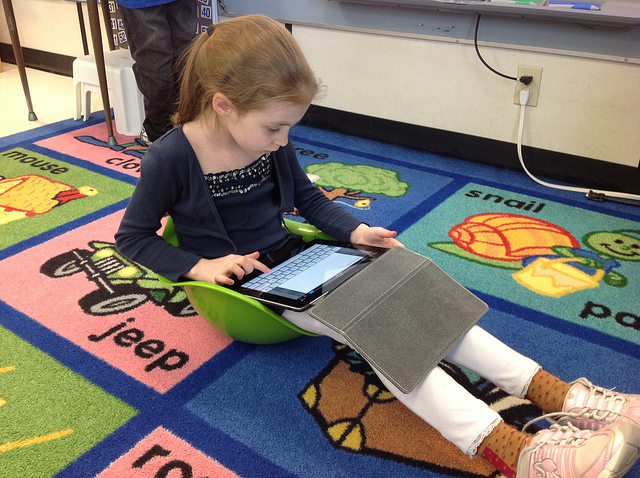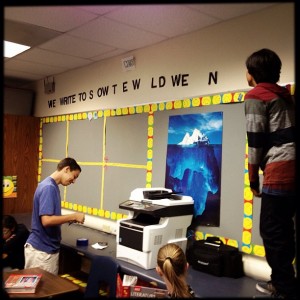Photo by Kathy Cassidy
I’ve been a blogger since 2009, but I’ve been a writer for always.
When I was principal, I wanted our students to have safe spaces where they could share their writing with the world and learn to proficiently use digital tools to make their voices heard. I wanted for them to be able to share their ideas with families and friends. I wanted others to be able to comment on the creativity and ideas expressed. I wanted our kids to connect globally with other classrooms and students. I wanted them to refine and enhance the ways in which they communicate with others.
I wanted.
Why?
Because I think it matters. Communication matters.
In my years as principal we introduced blogging to classrooms of students, beginning first with teachers who were eager to embrace blogging as a venue through which students could communicate their ideas and share their learning. Many teachers found natural uses of blogging in a variety of subject areas, from free writes to summarizing key learning to creative storytelling.
We used Kidblog in the beginning, and we still do. One of my first tasks in my new role as elementary tech integrator was to create Kidblog spaces for all students and teachers grades 2-6, district-wide. One of the things I disliked about how we used Kidblog in past years is that we had to “start fresh” with a new class each year, and our teachers were managing all of their own accounts. Now I have the ability to manage all of the accounts and simply move students into their new class next school year, which will maintain the work and writing they’ve done this year in the same space.
I have some continued wishes for blogging in our schools:
We need to “move beyond pockets of excellence in blogging“. I’d like to see more kids start blogging, and I’d like to support their teachers through this process. The spaces are set up, but there’s no mandate in place that says students must blog. How will that happen? With support, guidance, modeling, showcasing the great work that’s already being done, and time. And a little nagging 🙂 As Silvia Tolisano states in her post about pockets of blogging excellence, we can see the positive effects of blogging in a classroom where students are blogging, but
What we CAN’T do with pockets of excellence is to track and identify LONG TERM gains in blogging as a LEARNING PLATFORM.
Check out Tolisano’s blogging framework to support the practice in the elementary grades.
I’d like to see our use of Kidblog morph into digital student portfolios, spaces for students to showcase and share their work (and not just the “finished product,” but allow glimpses into the learning process as it unfolds).
I’d love for more of our teachers and administrators to embrace blogging, not just as a form of home-school communication (although that’s a great start), but to creatively express themselves and share their ideas with families and other educators. These are the blogging resources I share with staff via our elem. tech blog.
We need to better involve parents and families. When we first started blogging, my genius grade 2 team developed and hosted a Family Blog Night, where they invited parents and students to learn more about blogging, Kidblog, and commenting. After the teachers shared their info, parents and students logged into the student accounts for the first time to compose the first blog post together! Read more about this event here.
I’m eager to work with more classrooms to help students learn about quality commenting and engaging in respectful discourse. I rarely, if ever, read the comments sections of online news sites, which more often than not are riddled with vulgarity, ignorance, a wealth of conventional errors, and disrespect. I seriously want our students to understand that they are capable of communicating their unique ideas in ways that do not disrespect others or cause harm.
I want students to understand that blogging is about writing and reading. I want to connect them with great blogs to read, help them learn how to organize feeds, support their efforts to make sense of the information they find online, and help them discover how to apply it to their own learning. I’ll continue using the #comments4kids community to help student voices shine.
Do I think all students will love blogging? No. Do I think they need to be skilled communicators? Yes. So I’m not in favor of mandating x number of posts are required x number of days per week, or dictating every type of post we ask kids to write. Student ownership and product/process choice is still key. But while a post like this from one of our fifth graders breaks my heart just a little, I’m glad that this quiet young man once again has a medium through which he can share with the world:
This image from Stephen Davis came through my Instagram feed and its caption really struck a chord with me:
We write to show the world we think.
Image by Stephen Davis
When our kids write, they think. If they blog and publish and share, they think aloud and think visibly.
How are you supporting your students in the quest to help them become authentic writers and visible thinkers?




I have thought a lot about blogging over the past six years, especially student blogging. There are definitely huge positives about getting kids to write, regardless of the medium. When I look at what a blog adds to the writing I think about the connections that have been made through them.
I truly believe that social media, especially blogging, can lead to world peace. That isn’t hyperbole, when students connect with others and create online communities they begin to understand that humanity is not a national characteristic.
Thanks for writing this excellent blogging post.
Will, as soon as I saw you commented I realized I forgot to include #comments4kids in my post as a valuable resource to connect kids with other student writers. It’s what I use when I want to share our students’ work with others! Thanks for the important work you do in sharing students’ voices with the world!
Lyn, this post is so timely! I just created two blogs (2nd & 3rd grade) using Kidblog, per your advice and that of William Chamberlain.
I love where you state: “I’d like to see our use of Kidblog morph into digital student portfolios, spaces for students to showcase and share their work (and not just the “finished product,” but allow glimpses into the learning process as it unfolds).”
It is so helpful for the blogger and reader when learning is documented and shared transparently. Thank you for sharing this comprehensive ‘bit about blogging.’ The resources you have provided, and your reflection are really helpful!
Hi, Debbie, I’m glad you find this post and the resources shared within helpful as you embark on the wonderful journey of student blogging! Please share what your kiddos are up to!
Lyn,
I love what you said about thinking, writing, blogging and how blogging allows our students to think visibly and aloud. It’s so true. So many students write for an audience of 1 or a few and this affords them the opportunity and potential for a wider audience.
I also echo what Debbie said about this being timely. I too just helped some teachers get set up with their classroom kidblogs. Now, I need to find some other grade level classes to add to their blog roll so the students can read and connect with other student bloggers!
Hope all is well with you and your family!
Debra
Hi, Debra, thanks for sharing here! We’d love to connect our classes with yours, if you ever want to do so, just find me on Twitter or email me! lynhilt@gmail.com